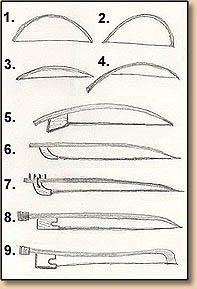In its traditional form, the bow was a curved stick, with horse hair stretched from end to end. In the fifteenth century the bow began to take on its present form. Both the English word bow and the Italian arco, indicate that it was originally convexly curved like the hunter's bow. The violin bow took on its modern form through a gradual process of change.
The developer of the modern bow was the Frenchman F. Tourte (1747-1835). The stick is of Pernambuco or Brazil wood which is curved to take the taut horsehair. The concave curve onto the horsehair arrived in the 1780's. The modern bow has an even greater concave curve than in Tourte's day.
The centre of balance of the bow is at one third of its length from the stock end. The horsehair is wedged into a hole in the point of the bow, and similarly fixed into the frog, at the other end. This method of fixing makes changing the hair simple. This is necessary from time to time, as the horsehairs have to be renewed when they wear thin. The screw at the hand end of the bow penetrates a threaded nut inside the frog. This mechanism is used to regulate the tension of the horsehair. Earlier, tension was controlled by various finger grips on the hair itself, or by a simple locking device on the frog. Friction between the string and the horsehair is improved by rubbing rosin (colofonium) on the hairs, producing more sound.

1. - 4.Development began from hunting-bow kind of bow
5.During 1200's bow had a frog. This helped to attach the horsehairs
6.At the end of 1600's the apex of bow sharpened. Frog was still fixed
7.1680's bow had an interlocking system for frog. This enabled the primitive way to adjust the firmness of horsehair
8.Beginning of the 1700's bow had a set screw that made it easier to adjust the firmness of horsehair
9.Bow developed by Tourte at the 1780's. The modern bow is even more curved